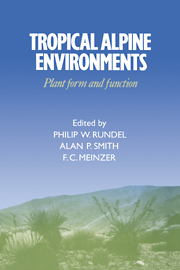Book contents
- Frontmatter
- Contents
- List of contributors
- Preface
- 1 Introduction to tropical alpine vegetation
- 2 Tropical alpine climates
- 3 Páramo microclimate and leaf thermal balance of Andean giant rosette plants
- 4 Comparative water relations of tropical alpine plants
- 5 Cold tolerance in tropical alpine plants
- 6 Anatomy of tropical alpine plants
- 7 Environmental biology of a tropical treeline species, Polylepis sericea
- 8 Morphological and physiological radiation in páramo Draba
- 9 Sediment-based carbon nutrition in tropical alpine Isoetes
- 10 Functional significance of inflorescence pubescence in tropical alpine species of Puya
- 11 Turnover and conservation of nutrients in the pachycaul Senecio keniodendron
- 12 Soil nutrient dynamics in East African alpine ecosystems
- 13 An overview of the reproductive biology of Espeletia (Asteraceae) in the Venezuelan Andes
- 14 Population biology of Mount Kenya lobelias
- 15 Population biology of Senecio keniodendron (Asteraceae), an Afroalpine giant rosette plant
- 16 Population dynamics and flowering in a Hawaiian alpine rosette plant, Argyroxiphium sandwicense
- 17 Plant form and function in alpine New Guinea
- 18 Alpine herbivory on Mount Kenya
- 19 Biotic interactions in Hawaiian high elevation ecosystems
- 20 Tropical alpine ecology: progress and priorities
- Index
1 - Introduction to tropical alpine vegetation
Published online by Cambridge University Press: 21 October 2009
- Frontmatter
- Contents
- List of contributors
- Preface
- 1 Introduction to tropical alpine vegetation
- 2 Tropical alpine climates
- 3 Páramo microclimate and leaf thermal balance of Andean giant rosette plants
- 4 Comparative water relations of tropical alpine plants
- 5 Cold tolerance in tropical alpine plants
- 6 Anatomy of tropical alpine plants
- 7 Environmental biology of a tropical treeline species, Polylepis sericea
- 8 Morphological and physiological radiation in páramo Draba
- 9 Sediment-based carbon nutrition in tropical alpine Isoetes
- 10 Functional significance of inflorescence pubescence in tropical alpine species of Puya
- 11 Turnover and conservation of nutrients in the pachycaul Senecio keniodendron
- 12 Soil nutrient dynamics in East African alpine ecosystems
- 13 An overview of the reproductive biology of Espeletia (Asteraceae) in the Venezuelan Andes
- 14 Population biology of Mount Kenya lobelias
- 15 Population biology of Senecio keniodendron (Asteraceae), an Afroalpine giant rosette plant
- 16 Population dynamics and flowering in a Hawaiian alpine rosette plant, Argyroxiphium sandwicense
- 17 Plant form and function in alpine New Guinea
- 18 Alpine herbivory on Mount Kenya
- 19 Biotic interactions in Hawaiian high elevation ecosystems
- 20 Tropical alpine ecology: progress and priorities
- Index
Summary
The general term ‘tropical alpine’ refers to regions within the tropics occurring between the upper limit of continuous, closed-canopy forest (often around 3500–3900 m) and the upper limit of plant life (often around 4600–4900 m: Hedberg 1951, 1964; Beaman 1962; Troll 1969; Wade & McVean 1969; Wardle 1971; Van der Hammen & Ruiz 1984; Vuilleumier & Monasterio 1986; see Figure 1.1) and is used in preference to regional terms such as ‘páramo’ and ‘jalca’ in the moist Andes from Venezuela to Northern Peru, ‘puna’ in the drier central Andes, and ‘Afroalpine’ and ‘moorland’ in Africa. No clear lower boundary can be defined where natural timberline has been eliminated by man, as in many areas of the Andes and Papua New Guinea (Wade & McVean 1969; Hope 1976; Ellenberg 1979; Ruthsatz 1983), or where the forest is patchy or absent due to low rainfall, as on the north slope of Mount Kenya (Coe 1967; Figure 1.2) and the western slopes of the Peruvian Andes (Weberbauer 1911). In these cases alpine species merge gradually with species of montane pasture, savanna or desert.
Physiognomy of tropical alpine vegetation varies greatly with climatic and edaphic factors; however, certain trends are held in common by many New and Old World tropical alpine areas (see, for example, Hedberg 1964; Coe 1967; Cuatrecasas 1968; Wade & McVean 1969; J. Smith 1977, 1980; Cleef 1978), suggesting convergent evolution (Hedberg & Hedberg 1979; Halloy 1983; Smith & Young 1987).
- Type
- Chapter
- Information
- Tropical Alpine EnvironmentsPlant Form and Function, pp. 1 - 20Publisher: Cambridge University PressPrint publication year: 1994
- 11
- Cited by



